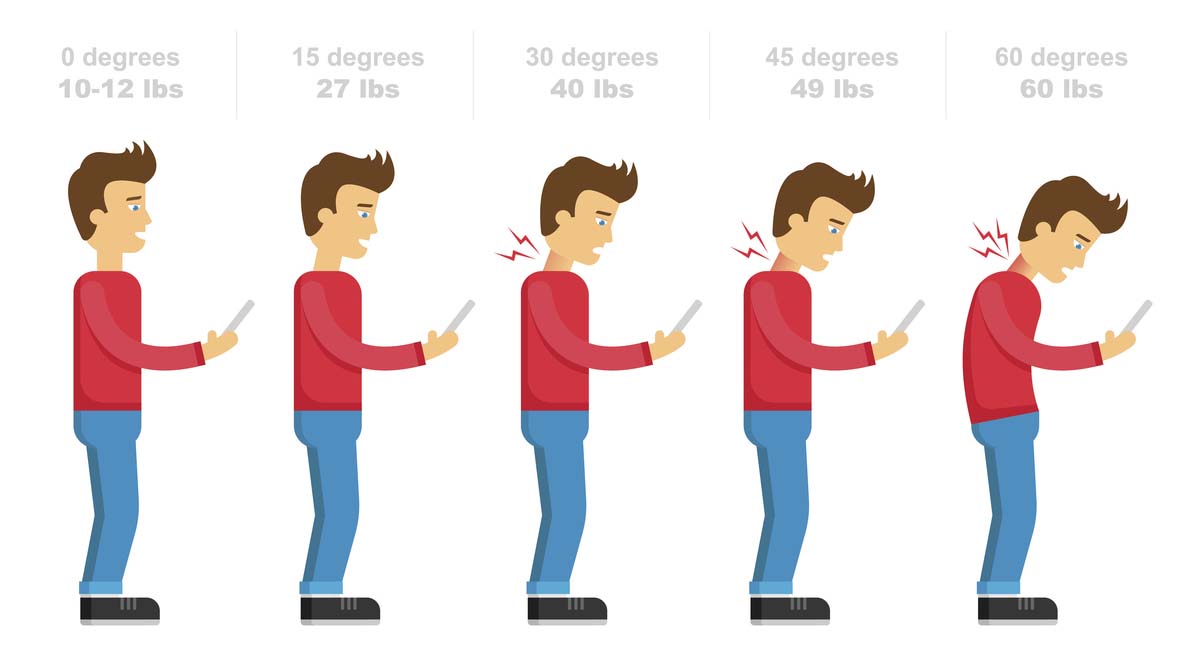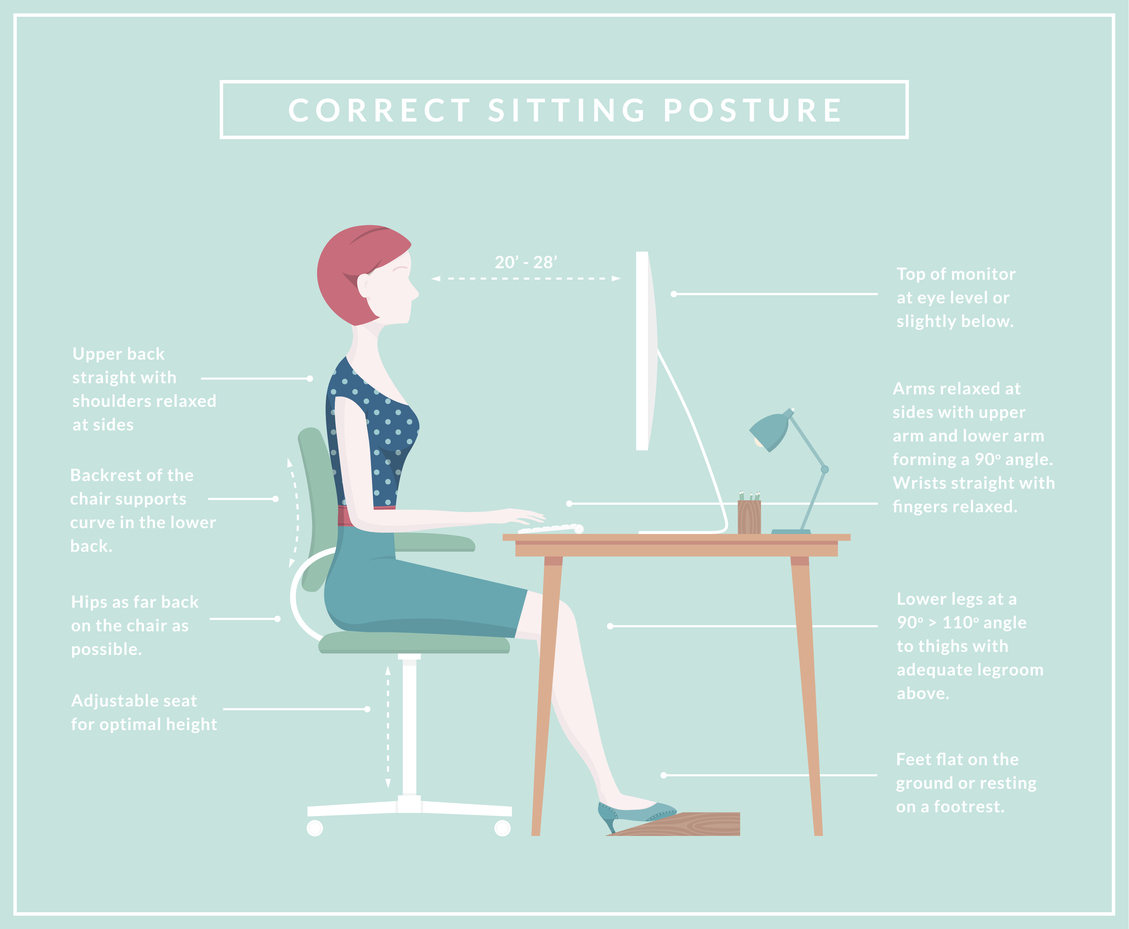by Luke Thomas
A desk job can be deceiving. On the surface, sitting in an adjustable, ergonomic chair for most of the day seems good for the body. But as many of us have discovered, it can often cause pain, tightness, and even fatigue if done improperly. In fact, Chicago-based sports chiropractor Dr. Krystal Drwencke revealed that desk work can be as hard as manual labor on some areas of the body.
In the office, we know it’s important to walk with purpose, but it’s also important to sit with purpose. – Casey Quattlebaum
The good news is that pain from deskwork is easily prevented. Read on to discover the causes of this discomfort, and what other Strong employees have been doing to avoid it.
What Causes the Pain?
Here are some of the most common problem areas and the behaviors associated with them.

- Neck/Spinal Pain – Usually, neck pain is caused by not holding your head in line with your spine. You can see in the photo above that the relative weight of your head increases from 11 lbs to a whopping 60 lbs when looking all the way down. While you may not be at a full 60-degree angle, you could still be looking down at your computer screen, causing the relative weight of your skull to double or even triple.
- Lower Back Pain – If your lower back is giving you trouble, it’s likely not getting the support it needs. While Strong’s office chairs are designed to provide ergonomic lumbar support, this may not be enough depending on your height and build. Having weak core muscles and crossing your legs while sitting can also lead to lower back strain.
- Shoulder/Upper Back Pain – The trapezius and rhomboid muscles are the culprits here. Not having your monitor directly in front of you, positioning your keyboard too far away, and hunching your shoulders forward can cause pain and knots in between the shoulders and all along the upper portion of the body. Tight pectoral muscles are caused by and exacerbate the issue, too.
How to Relieve the Pain
There are a few quick fixes that you can use to relieve deskwork pain.
In the Graphics department, both Emily Johnson and Sheryl Jones are fans of self-myofascial release.
“I use a foam roller to work out tight muscles all down the back and front of my legs, side of my hips, and even my stomach and hip flexors,” Jones said.
Johnson mentioned using a tennis ball for a more concentrated form of self-massage, which is particularly useful for targeting pain and tightness between the shoulder blades. This is a technique also recommended by Strong’s monthly massage therapists. They recommend placing the ball in a long tube sock to make it easier to reach the back area. By placing the ball between your back and a wall, you can apply steady, targeted pressure to problem areas. The key to finding relief is to linger when you find a knot or trigger point, then breathe through the hold and try to relax into the ball. This will allow the ball to massage deeper into the muscle and relieve the tension that’s causing the pain.
Jones also does a lot of stretch work to help relieve and prevent her lower back pain. She recommends the Cat Pose from yoga, leg raises with resistance bands, and taking a brief stretch break once or twice a day to break up your sitting. Another way to relieve lower back pain without even leaving your desk is to gently rock your pelvis front-to-back a few times. This will loosen up tight back muscles and increase blood flow to the area.
To relieve neck pain, try releasing your neck down and looking to one side. Make sure to leave the opposite arm loose by your side, and you should feel a stretch in your neck and trapezius muscles.
Casey’s Pain Prevention Method

As they say, an ounce of prevention is worth a pound of cure.
Casey Quattlebaum offered some advice for maintaining a healthy desk posture. After recovering from a ruptured spinal disk eight years ago, she places a lot of importance on proper alignment.
“A big tip is to keep your core engaged at all times,” Quattlebaum said. “If you keep everything sucked in, your posture will naturally straighten up. Also, keep your feet flat on the floor, and don’t slump into the phone if you don’t have a headset. Another trick I use is to swap my mouse position every month. This keeps me from leaning too much on one arm over time. I also placed filing trays underneath my monitors so that they’re raised to eye-level. This keeps me from looking down and putting a strain on my neck.”
One of the best pieces of advice Quattlebaum gave was to sit with purpose.
“In the office, we know it’s important to walk with purpose, but it’s also important to sit with purpose,” Quattlebaum said. “Being aware of your posture and letting it reflect your determination will help you avoid slouching or reclining too hard.”
A Few More Tips
In addition to Quattlebaum’s posture suggestions, there are a couple of more techniques you can use for correcting bad posture and the discomfort that it produces. For lower back pain, try placing a small pillow behind your back for additional lumbar support. Jones also found that a slightly elevated footrest helps with this.
For shoulder and upper back pain, consider doing a few minutes of pectoral stretches every day. This video explains how to do so using only a doorframe. Slouchy shoulders cause the pectoral muscles to become tight and pull on the rhomboid (back) muscles, so by stretching the pecs out, you’ll lessen the related tightness in your back.
If you have any tips of your own for staying comfortable at your desk, share them in the comments below!